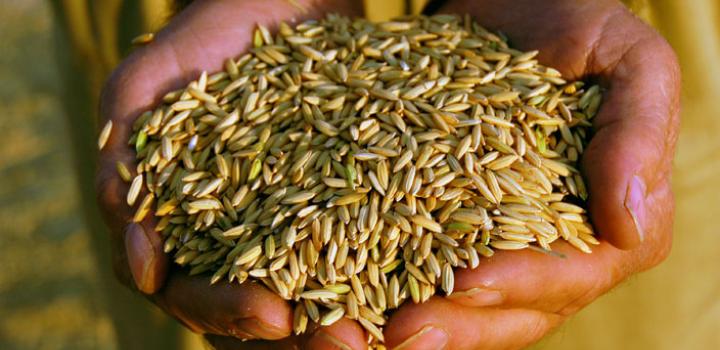Growing rice in rows becoming more popular in Arkansas
by July 9, 2018 4:55 pm 2,941 views

Flooded rice paddies, protected by a series of levees, have been the norm in the Arkansas Delta for many years. During the 1980s farmers experimented with systems that allowed rice to be grown in standard rows, but those fields produced a lot of blast fungus, a disease that can damage or kill a rice plant.
Science has been able to stem that trend, and rice rows have steadily grown in recent years University of Arkansas Division of Agriculture rice agronomist Dr. Jarrod Hardke told Talk Business & Politics. The number of rice row acres has jumped from 40,000 in 2017 to more than 100,000 acres this year, he said.
“It’s certainly very scattered,” Hardke said. “For the most part, you don’t have individual growers going too heavily into it, although there are a handful who have. Many growers are just trying a field here and there. But spreading that across 1.4 million acres, ‘here and there’ starts to add up.”
The reason some farmers prefer the row method is input cost savings, Hardke said. A typical rice acre has about $750 in input costs. Growing rice in rows can save a producer up to $70 per acre, per season, he said. Rice in rows can be grown in former soybean beds, meaning they don’t have to be prepped like typical rice paddies. This can save a farmer many hours on their combines and other equipment, Hardke said, adding that those fields don’t require the levee systems, and are irrigated with pipes, much like other row crops.
Stuttgart farmer Trent Dabbs and his father have worked row rice for more than a decade. In the beginning, “quite a few people thought we were crazy, but it’s worked out pretty good for us,” he said. They started small – one field, 40 acres. This year, the Dabbses have about 200 acres in row rice and may expand that acreage again next year.
Row rice means “less time creating levees and putting in gates” and “during harvest, there’s less wear and tear on the combines. You’re not jumping levees and it’s not as muddy,” Dabbs said.
Hardke said row rice does typically require more nitrogen than flooded rice, as well as the potential for more intensive pest management. Even with the changes in production practices, “we don’t see a big yield drag,” Dabbs said.
“We’ve had to make some changes in our production practices; we changed our fertility and spraying to make it work,” Dabbs said. “Instead of doing a large pre-flood shot of fertilizer, we split it into three applications to spoon feed the rice and not lose nitrogen.”
Dabbs said he uses row rice on sandier areas, fields that have difficulty holding water, and fields where he might plant no-till soybeans behind rice. Yields in row rice have historically been similar to those in flooded rice, although 2017 may have provided a skewed example for Arkansas growers. Rice farmers in the state planted 1.161 million acres last year, about 47.1% of all rice acres planted in the U.S. Those acres accounted for 82.6 million hundredweight of rice, and it represented 46.4% of the 178.2 million hundredweight produced in the country.
During the last three years, Arkansas has accounted for more than 47% of the nation’s total rice production, according to federal reports. Per acre, farmers had a yield of 164.4 bushels per acre or 7,400 pounds. It was the third highest yield on record in the state and a 570 pound per acre uptick from 2016.
“One of the dangers we tried to emphasize was that some of last year’s success was due to weather conditions,” Hardke said. “We had very good yields across the board, with excessive amounts of in-season rainfall, which made growing rice in those environments that much easier. We had some concerns going into this year that we would end up hot and dry, and well, we have. That’s going to make managing those fields a little more difficult, depending on local conditions and agronomic set-ups.”
Hybrid varieties of rice make the row system possible. About half of Arkansas’ rice acreage or 700,000 acres is hybrid, Hardke said. Hybrids can develop resistance to diseases such as blast fungus, but a hybrid blend can only be used for one growing season. Hybrids are produced when one part infertile male pollen and one fertile male pollen are combined to produce an offspring, he said. These hybrids tend to produce better yields and are more disease resistant, he said.
Most of the row rice fields are not typical or traditionally poor producing fields, Hardke said.
The state’s rice crop is on schedule and nothing significant has impacted it, Hardke said. But, there are concerns on the horizon. Temperatures have remained extremely hot for the last several weeks and the humidity has been high. These conditions are conducive to cultivating fungicide diseases. Dry conditions could also impact irrigation, he said.
“We still need rain, for sure,” he said.
